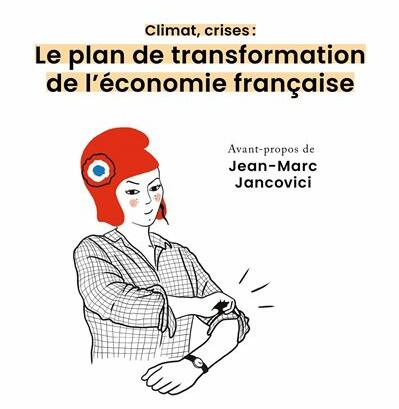 On the 8th of March 2018, the European Commission published its action plan to promote the emergence of sustainable finance, based on a planning that has been adjusted from mid-2018 to the end of 2019. This Action Plan is based on the recommendations made by the High-Level Experts Group on sustainable finance (HLEG) a few weeks earlier. The objectives set by the European Commission, broken down into ten actions, reinforce the findings established in the study “Climate risk analysis: actors, methodologies, perspectives” carried out for Afep (French private companies association) by R. Grandjean, M. Lepetit and L. Morel, 3 experts from The Shift Project and published in February 2018.
On the 8th of March 2018, the European Commission published its action plan to promote the emergence of sustainable finance, based on a planning that has been adjusted from mid-2018 to the end of 2019. This Action Plan is based on the recommendations made by the High-Level Experts Group on sustainable finance (HLEG) a few weeks earlier. The objectives set by the European Commission, broken down into ten actions, reinforce the findings established in the study “Climate risk analysis: actors, methodologies, perspectives” carried out for Afep (French private companies association) by R. Grandjean, M. Lepetit and L. Morel, 3 experts from The Shift Project and published in February 2018.
 The President Emmanuel Macron recalled that the European Union “must assume the climate leadership” in his speech of the 22nd of March 2018 in Brussels. In particular, he stressed the need to mobilize the necessary investments for the energy transition by relying on a European pro-climate financial system and on the need for financial players to take better account of the “sustainability objectives“.
The President Emmanuel Macron recalled that the European Union “must assume the climate leadership” in his speech of the 22nd of March 2018 in Brussels. In particular, he stressed the need to mobilize the necessary investments for the energy transition by relying on a European pro-climate financial system and on the need for financial players to take better account of the “sustainability objectives“.
The European Commission’s Action Plan has set itself the objective of addressing these two aspects by developing a taxonomy of sustainable activities – first and foremost in the area of climate change – by supporting the systematic integration of sustainability into risk management (evolution of the supervision of rating agencies and investors regarding ESG criteria) and by promoting transparency and a long-term vision (improved availability and quality of information, reflection on the role of accounting standards).
The Shift Project welcomes this dynamic, which should quickly clarify the issues to enable companies and investors to implement their climate strategies with full knowledge of the facts.
Climate change, « primus inter pares »
The European Commission’s Action Plan focuses on climate. By far, Climate change related risks (physical and transition risks) are acknowledged as the most urgent and will be addressed as a priority, notably in the development of the taxonomy of sustainable activities (see below).
While climate remains largely integrated into the broader ESG (Environmental, Social and Governance) analysis in most European laws and regulations, the European Commission’s statements indicate that this subject will become increasingly autonomous. The Shift Project‘s analysis stresses that this empowerment should be further accelerated, taking into account the materiality of climate change related risks, their fundamental capacity to be quantified, their systemic dimension, as well as the very alarming current trajectory of global greenhouse gas emissions.
A priority: climate taxonomy
Defining a taxonomy is the most urgent priority of the European Commission’s Action Plan. It is a EU common classification system that should allow investors to identify which sectors of activity can be considered “sustainable”. The objective is to ensure the quality, comparability and reliability of financial products associated with investments in sustainable sectors and to facilitate such investments.
The implementation schedule should not exceed two years and the priority is clearly focused on identifying projects and activities that contribute to reducing GHG emissions and then adapting to climate change (Action 1; “While taxonomy development work will focus primarily on climate change mitigation, it will gradually extend to adaptation to climate change and other environmental issues and, subsequently, to social sustainability”).
Such a taxonomy is seen as a prerequisite for many other measures in the Action Plan.
A high-risk environment
In the introductory paragraph of the Action Plan, the European Commission stresses the upheavals to which European countries, among others, will be exposed if they remain inactive, with particular reference to the physical limits of the environment (“Faced with the catastrophic and unpredictable consequences of climate change and resource depletion, public authorities must act urgently to adapt their policies to this new reality”). The acknowledgement by public policy makers of physical factors underlying the human societies’ development is one of The Shift Project’s main lines of action, which can only welcome this mention.
Towards a more climate-friendly regulation
The Commission’s Action Plan emphasises the need for more ESG-sensitive financial legislation and regulation, including climate regulation. This implies a strengthening of the role of the European Supervisory Authorities (ESAs), which are invited to mobilize themselves in this perspective. The Commission states that these agencies “should play an important role in assessing and reporting on the risks to financial stability posed by sustainability factors“.
This dynamic is in line with a situation clearly identified by The Shift Project’s analysis, which highlights the absence of significant European regulation in terms of climate risk analysis.
A possible evolution in the regulation of financial rating agencies
In its study, The Shift Project recalls the need for significant resources and expertise to conduct a relevant analysis of climate change related risks and opportunities and draws attention to the following aspects:
- the too limited and insufficiently explicit consideration of these risks in the credit rating of companies by financial agencies (the “tragedy of horizons”, to use the expression of Mark Carney, Governor of the Bank of England);
- the heterogeneity of methodologies and the lack of resources affecting the climate rating sector and the ESG sector as a whole.
The Commission’s Action Plan largely confirms the same findings. While the analysis of extra-financial risks is not currently supervised by any regulator, the 6th point of the Plan proposes a series of measures to address the situation by encouraging the explicit inclusion of ESG criteria in the analysis process of credit rating agencies. In this respect, the European Securities and Markets Authority (ESMA) is asked to include ESG criteria in its guidelines for reporting done by these agencies by the second quarter of 2019. The Commission also plans to launch a study on the non-financial rating market (structure, analysis of players and methodologies), aimed at fostering the development of a mature and less concentrated market.
Toward a publication of information better supervised and with better quality
The non-financial reporting issue appears to be one of the Commission’s priorities. On this subject, the Shift Project’s study stresses that, in terms of climate, a real challenge of quality and homogeneity of quantitative and qualitative “climate information” persists.
Here again, the Commission’s action plan is based on a similar observation and aims to improve the transparency and formalisation of non-financial information published by all economic players (companies and investors). This includes notably :
- guidelines on non-financial reporting revision, notably “climate”, in order to make it compatible with the recommendations of the Task Force on Climate-related Financial Disclosures (TCFD, including information on the use of energy-climatic scenarios) and the indicators of the future European taxonomy;
- the creation, from the third quarter of 2018, of a European laboratory on corporate reporting, under the aegis of EFRAG (Consultative Group for Financial Information in Europe, chaired by J.-P. Gauzes). This body will aim to promote and encourage the adoption of best practices in non-financial reporting.
The impact of accounting standards (IFRS) on long-term investment is also the subject of Commission Action Plan. It is also interesting to note that this action is presented in the chapter dealing with non-financial information, inducing the need for consistency between financial accounting and carbon.
Evolution of investors’ duties
In its approach, the Commission is mindful of asset managers and institutional investors and wishes to present, by mid-2018, a legislative proposal requiring these players to state how they take ESG criteria, including climate, into account in their investment strategy and decisions.
It should be noted that this measure is in line with the Article 173-6 of the French Energy Transition for Green Growth Act (LTECV). Let us recall that The Shift Project has developed under the direction of Mr. Lepetit, a leading observatory of the application of article 173 by the financial sector: the Climate Life Insurance Observatory 173.
President Macron was remarkably clear in Brussels: “Risk is at the heart of finance. Investors need to measure more systematically what climate risk is and its financial consequences. […] We must now aim to a widespread transparency to all European companies and investors.”
Index management
While passive index management is undergoing very significant development, the Commission stresses the “lack of transparency of the methods used” and the need for more “transparency and solidity in order to reduce the risks of eco-money laundering“. In this sense, it proposes to develop the regulation governing the production of indices and to present an initiative to harmonise the methodologies for building low-carbon indices, in particular on the basis of indicators for the future European taxonomy.
In its study, The Shift Project pointed out that the criteria for building most “low carbon” indices include only a partial and static view of “climate” risk (generally data scope 1 and scope 2 data). In this sense, it is necessary that they take into account a vision as complete as possible of these risks by integrating the scope 3 and prospective elements.
Such a decision by the Commission could change the fundamentals of the low-carbon index management market in the right direction.
What is not included in the Commission Action Plan
If the consideration of long-term criteria is promoted, as well as measures to combat short-term market behaviour (Action 10), the Commission’s Action Plan could have further underlined the importance of scenario-based risk analysis.
For example, the published text suggests that European financial sector supervisors “[…] could develop a common EU methodology for relevant scenario analyses, which could later evolve towards climate/environmental stress testing“. It should also be added that the application of the TCFD recommendations, clearly promoted by the Action Plan (see Action 9), includes the publication, by certain companies, of information on the use of energy-climatic scenarios (including a 2°C scenario) to manage their climate change related risks.
In its study, The Shift Project found that energy-climate scenarios are essential for assessing a company’s viability in a low-carbon world. However, the publication of information on the use of scenarios still seems to raise many strategic questions for companies (sensitivity of the information manipulated, projection horizon, robustness of assumptions, comparability, coverage, sector-specific issues).
A clearer positioning of the Commission would have been welcome, in order to advance the reflection on this subject and the deployment of practices shared by companies. President Macron paved the way in Brussels: “We have thus defined a strategy of carbon neutrality by 2050 […] I wish to build, during the years when I am at the head of my country, the trajectory and the concrete strategy which will make it possible to succeed”.
Conclusion
The Commission’s Action Plan is of interest and satisfaction in several ways. It makes climate change related issues its main concern; it seems that it seeks to fill the gap in the regulation of climate and ESG risk analysis; finally, it extends the dynamics of TCFD within the financial sphere.
However, there could be many obstacles to its implementation and the risk of institutional discussions becoming bogged down is not negligible.
This is an emergency.
Authors : Romain Grandjean (romain.grandjean@theshiftproject.org) and Michel Lepetit

